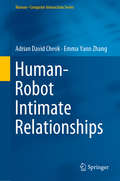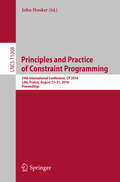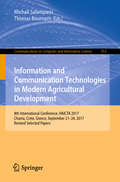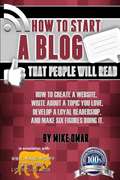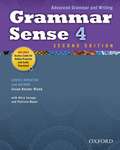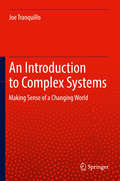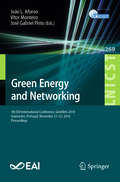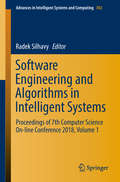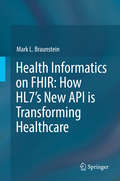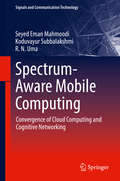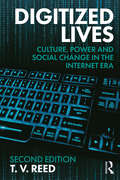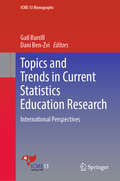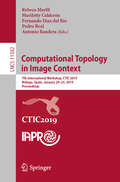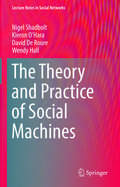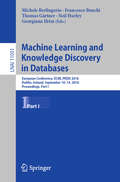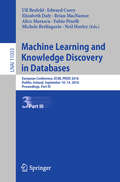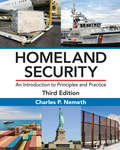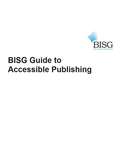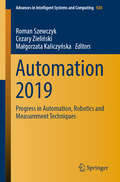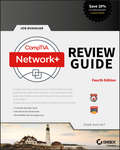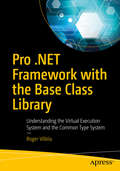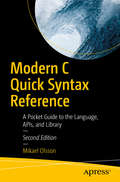- Table View
- List View
Human–Robot Intimate Relationships (Human–Computer Interaction Series)
by Adrian David Cheok Emma Yann ZhangThe idea of humans falling in love with artificial beings is not a modern conception. Our relationship with artificial partners has come a long way since Pygmalion and his ivory lover. In recent years, there has been a strong upsurge of interest and discussions in the various aspects of intimate relationships between humans and artificial partners. This interest is evidenced by the increase in media coverage, TV documentaries and films on this topic, as well as the active research efforts within the academic community. This book provides a comprehensive collection and overview of the latest development in the field of intimate relationships between humans and artificial partners, in particular robots and virtual agents. It includes relevant research work undertaken by the authors, the latest advancements in technology and commercial products, and future predictions and insights from leading experts in the area. This book contains an in-depth discussion of the engineering, philosophical, psychological, ethical, and sociological implications of relationships with artificial companions. It also gives a glimpse of some future directions of artificial intelligence, human-computer love and sexual interaction, robotics engineering etc. It is a great resource for researchers and professionals working in these areas. The narrative style of the book also makes it an enjoyable and educational read for everyone.
Principles and Practice of Constraint Programming: 24th International Conference, Cp 2018, Lille, France, August 27-31, 2018, Proceedings (Lecture Notes in Computer Science #11008)
by John HookerThis book constitutes the proceedings of the 24th International Conference on Principles and Practice of Constraint Programming, CP 2018, held in Lille, France, in August 2018.The 41 full and 9 short papers presented in this volume were carefully reviewed and selected from 114 submissions. They deal with all aspects of computing with constraints including theory, algorithms, environments, languages, models, systems, and applications such as decision making, resource allocation, scheduling, configuration, and planning. The papers were organized according to the following topics/tracks: main technical track; applications track; CP and data science; CP and music; CP and operations research; CP, optimization and power system management; multiagent and parallel CP; and testing and verification.
Information and Communication Technologies in Modern Agricultural Development: 8th International Conference, Haicta 2017, Chania, Crete, Greece, September 21-24, 2017, Revised Selected Papers (Communications in Computer and Information Science #953)
by Michail Salampasis Thomas BournarisThis book constitutes the thoroughly refereed post-conference proceedings of the 8th International Conference on Information and Communication Technologies in Agriculture, Food and Environment, HAICTA 2017, held in Chania, Crete, Greece, in September 2017. <p><p> The 14 revised full papers presented in this book were carefully selected from the 55 accepted full papers out of 124 submissions. The selected papers span across various subjects, from ICT innovations and smart farming, to decision support systems, as well as precision farming, disease diagnosis using mobile devices, IoT for monitoring and controlling animal production, sensor-based solutions, GIS-based water management, environmental planning, information systems for monitoring of fish stocks and fisheries, information management in the agri-food sector, and forestry planning and management.
How to Start a Blog that People Will Read
by Mike OmarEvaluate business ideas much more intelligently once you've gone through this whole process. This is because you will understand the fundamentals of keyword research & analysis, traffic & lead generation, social & affiliate marketing, monetization & conversion testing, and traffic analysis. These skills will help you immensely in ANY business you ever decide to start.
Grammar Sense 4
by Susan KesnerGrammar Sense is a four-level discourse-based grammar series which focuses on the connection between form, meaning, and use of English structures. The series is based on the fundamental premise that English grammar is learnable and teachable if it is systematically organized and explained. Grammar Sense implements linguistic and applied linguistic research on how, where, when, and why native speakers use English structures, and how non-native speakers learn them. This series provides learners with a true understanding of how grammar is used in authentic contexts. Grammar is presented in discourse rather than in isolated sentences which allows the students to understand English grammar in real life situations.
Native Ads
by Brian GravesBasically, what we are doing in this special method is that we send cheap traffic to simple domains we own that have sponsored ads on them. How do we get the ads on the domains? We simply park the domain with a provider that will put the ads on our domain automatically.
An Introduction to Complex Systems: Making Sense of a Changing World
by Joe TranquilloThis book explores the interdisciplinary field of complex systems theory. By the end of the book, readers will be able to understand terminology that is used in complex systems and how they are related to one another; see the patterns of complex systems in practical examples; map current topics, in a variety of fields, to complexity theory; and be able to read more advanced literature in the field. The book begins with basic systems concepts and moves on to how these simple rules can lead to complex behavior. The author then introduces non-linear systems, followed by pattern formation, and networks and information flow in systems. Later chapters cover the thermodynamics of complex systems, dynamical patterns that arise in networks, and how game theory can serve as a framework for decision making. The text is interspersed with both philosophical and quantitative arguments, and each chapter ends with questions and prompts that help readers make more connections.
Green Energy and Networking: 5th EAI International Conference, GreeNets 2018, Guimarães, Portugal, November 21–23, 2018, Proceedings (Lecture Notes of the Institute for Computer Sciences, Social Informatics and Telecommunications Engineering #269)
by José Gabriel Pinto Vítor Monteiro João L. AfonsoThis book constitutes the refereed post-conference proceedings of the 5th EAI International Conference on Green Energy and Networking, GreeNets 2018, held in Guimarães, Portugal, in November 2018. The 15 full papers were selected form 26 submissions and cover a wide spectrum of ideas to reduce the impact of the climate change, while maintaining social prosperity. In this context, growing global concern leads to the adoption of the new technological paradigms, especially for the operation of future smart cities.
Software Engineering and Algorithms in Intelligent Systems: Proceedings Of 7th Computer Science On-line Conference 2018, Volume 1 (Advances In Intelligent Systems And Computing #763)
by Radek SilhavyThis book presents new software engineering approaches and methods, discussing real-world problems and exploratory research that describes novel approaches, modern design techniques, hybrid algorithms and empirical methods. This book constitutes part of the refereed proceedings of the Software Engineering and Algorithms in Intelligent Systems Section of the 7th Computer Science On-line Conference 2018 (CSOC 2018), held in April 2018.
Health Informatics on FHIR: How HL7's New API is Transforming Healthcare
by Mark L. BraunsteinThis textbook begins with an introduction to the US healthcare delivery system, its many systemic challenges and the prior efforts to develop and deploy informatics tools to help overcome those problems. It goes on to discuss health informatics from an historical perspective, its current state and its likely future state now that electronic health record systems are widely deployed, the HL7 Fast Healthcare Interoperability standard is being rapidly accepted as the means to access the data stored in those systems and analytics is increasing being used to gain new knowledge from that aggregated clinical data. It then turns to some of the important and evolving areas of informatics including population and public health, mHealth and big data and analytics. Use cases and case studies are used in all of these discussions to help readers connect the technologies to real world challenges. Effective use of informatics systems and tools by providers and their patients is key to improving the quality, safety and cost of healthcare. With health records now digital, no effective means has existed for sharing them with patients, among the multiple providers who may care for them and for important secondary uses such as public/population health and research. This problem is a topic of congressional discussion and is addressed by the 21st Century Cures Act of 2016 that mandates that electronic health record (EHR) systems offer a patient-facing API. HL7’s Fast Healthcare Interoperability Resources (FHIR) is that API and this is the first comprehensive treatment of the technology and the many ways it is already being used. FHIR is based on web technologies and is thus a far more facile, easy to implement approach that is rapidly gaining acceptance. It is also the basis for a ‘universal health app platform’ that literally has the potential to foster innovation around the data in patient records similar to the app ecosystems smartphones created around the data they store. FHIR app stores have already been opened by Epic and Cerner, the two largest enterprise EHR vendors. Provider facing apps are already being explored to improve EHR usability and support personalized medicine. Medicare and the Veteran’s Administration have announced FHIR app platforms for their patients. Apple’s new IOS 11.3 features the ability for consumers to aggregate their health records on their iPhone using FHIR. Health insurance companies are exploring applications of FHIR to improve service and communication with their providers and patients. SureScripts, the national e-Prescribing network, is using FHIR to help doctors know if their patients are complying with prescriptions. This textbook is for introductory health informatics courses for computer science and health sciences students (e.g. doctors, nurses, PhDs), the current health informatics community, IT professionals interested in learning about the field and practicing healthcare providers. Though this textbook covers an important new technology, it is accessible to non-technical readers including healthcare providers, their patients or anyone interested in the use of healthcare data for improved care, public/population health or research.
Distant Horizons: Digital Evidence and Literary Change
by Ted UnderwoodJust as a traveler crossing a continent won’t sense the curvature of the earth, one lifetime of reading can’t grasp the largest patterns organizing literary history. This is the guiding premise behind Distant Horizons, which uses the scope of data newly available to us through digital libraries to tackle previously elusive questions about literature. Ted Underwood shows how digital archives and statistical tools, rather than reducing words to numbers (as is often feared), can deepen our understanding of issues that have always been central to humanistic inquiry. Without denying the usefulness of time-honored approaches like close reading, narratology, or genre studies, Underwood argues that we also need to read the larger arcs of literary change that have remained hidden from us by their sheer scale. Using both close and distant reading to trace the differentiation of genres, transformation of gender roles, and surprising persistence of aesthetic judgment, Underwood shows how digital methods can bring into focus the larger landscape of literary history and add to the beauty and complexity we value in literature.
Spectrum-Aware Mobile Computing: Convergence of Cloud Computing and Cognitive Networking (Signals and Communication Technology)
by Seyed Eman Mahmoodi Koduvayur Subbalakshmi R. N. UmaThis book presents solutions to the problems arising in two trends in mobile computing and their intersection: increased mobile traffic driven mainly by sophisticated smart phone applications; and the issue of user demand for lighter phones, which cause more battery power constrained handhelds to offload computations to resource intensive clouds (the second trend exacerbating the bandwidth crunch often experienced over wireless networks). The authors posit a new solution called spectrum aware cognitive mobile computing, which uses dynamic spectrum access and management concepts from wireless networking to offer overall optimized computation offloading and scheduling solutions that achieve optimal trade-offs between the mobile device and wireless resources. They show how in order to allow these competing goals to meet in the middle, and to meet the promise of 5G mobile computing, it is essential to consider mobile offloading holistically, from end to end and use the power of multi-radio access technologies that have been recently developed. Technologies covered in this book have applications to mobile computing, edge computing, fog computing, vehicular communications, mobile healthcare, mobile application developments such as augmented reality, and virtual reality.
Digitized Lives: Culture, Power and Social Change in the Internet Era
by T. V. ReedIn chapters examining a broad range of issues—including sexuality, politics, education, race, gender relations, the environment and social protest movements—Digitized Lives argues that making sense of digitized culture means looking past the glossy surface of techno gear to ask deeper questions about how we can utilize technology to create a more socially, politically and economically just world. This second edition includes important updates on mobile and social media, examining how new platforms and devices have altered how we interact with digital technologies in an allegedly ‘post-truth’ era. A companion website (www.culturalpolitics.net/digital_cultures) includes links to online articles and useful websites, as well as a bibliography of offline resources, and more.
Topics and Trends in Current Statistics Education Research: International Perspectives (ICME-13 Monographs)
by Gail Burrill Dani Ben-ZviThis book focuses on international research in statistics education, providing a solid understanding of the challenges in learning statistics. It presents the teaching and learning of statistics in various contexts, including designed settings for young children, students in formal schooling, tertiary level students, and teacher professional development. The book describes research on what to teach and platforms for delivering content (curriculum), strategies on how to teach for deep understanding, and includes several chapters on developing conceptual understanding (pedagogy and technology), teacher knowledge and beliefs, and the challenges teachers and students face when they solve statistical problems (reasoning and thinking). This new research in the field offers critical insights for college instructors, classroom teachers, curriculum designers, researchers in mathematics and statistics education as well as policy makers and newcomers to the field of statistics education. Statistics has become one of the key areas of study in the modern world of information and big data. The dramatic increase in demand for learning statistics in all disciplines is accompanied by tremendous growth in research in statistics education. Increasingly, countries are teaching more quantitative reasoning and statistics at lower and lower grade levels within mathematics, science and across many content areas. Research has revealed the many challenges in helping learners develop statistical literacy, reasoning, and thinking, and new curricula and technology tools show promise in facilitating the achievement of these desired outcomes.
Computational Topology in Image Context: 7th International Workshop, CTIC 2019, Málaga, Spain, January 24-25, 2019, Proceedings (Lecture Notes in Computer Science #11382)
by Rebeca Marfil Mariletty Calderón Fernando Díaz del Río Pedro Real Antonio BanderaThis book constitutes the proceedings of the 7th International Workshop on Computational Topology in Image Context, CTIC 2019, held in Málaga, Spain, in January 2019. The 14 papers presented in this volume were carefully reviewed and selected from 21 submissions. Papers deal with theoretical issues but most of them put the attention on the applicability of concepts and algorithms. These were designed to deal with objects and images, but also with the speech signal. The final application must be for instance in the medical domain or in the robotics one.
The Theory and Practice of Social Machines (Lecture Notes in Social Networks)
by Nigel Shadbolt Kieron O’Hara David De Roure Wendy HallSocial machines are a type of network connected by interactive digital devices made possible by the ubiquitous adoption of technologies such as the Internet, the smartphone, social media and the read/write World Wide Web, connecting people at scale to document situations, cooperate on tasks, exchange information, or even simply to play. Existing social processes may be scaled up, and new social processes enabled, to solve problems, augment reality, create new sources of value, and disrupt existing practice.This book considers what talents one would need to understand or build a social machine, describes the state of the art, and speculates on the future, from the perspective of the EPSRC project SOCIAM – The Theory and Practice of Social Machines. The aim is to develop a set of tools and techniques for investigating, constructing and facilitating social machines, to enable us to narrow down pragmatically what is becoming a wide space, by asking ‘when will it be valuable to use these methods on a sociotechnical system?’ The systems for which the use of these methods adds value are social machines in which there is rich person-to-person communication, and where a large proportion of the machine’s behaviour is constituted by human interaction.
Machine Learning and Knowledge Discovery in Databases: European Conference, ECML PKDD 2018, Dublin, Ireland, September 10–14, 2018, Proceedings, Part I (Lecture Notes in Computer Science #11051)
by Michele Berlingerio Francesco Bonchi Thomas Gärtner Neil Hurley Georgiana IfrimThe three volume proceedings LNAI 11051 – 11053 constitutes the refereed proceedings of the European Conference on Machine Learning and Knowledge Discovery in Databases, ECML PKDD 2018, held in Dublin, Ireland, in September 2018. The total of 131 regular papers presented in part I and part II was carefully reviewed and selected from 535 submissions; there are 52 papers in the applied data science, nectar and demo track. The contributions were organized in topical sections named as follows: Part I: adversarial learning; anomaly and outlier detection; applications; classification; clustering and unsupervised learning; deep learningensemble methods; and evaluation. Part II: graphs; kernel methods; learning paradigms; matrix and tensor analysis; online and active learning; pattern and sequence mining; probabilistic models and statistical methods; recommender systems; and transfer learning. Part III: ADS data science applications; ADS e-commerce; ADS engineering and design; ADS financial and security; ADS health; ADS sensing and positioning; nectar track; and demo track.
Machine Learning and Knowledge Discovery in Databases: European Conference, ECML PKDD 2018, Dublin, Ireland, September 10–14, 2018, Proceedings, Part III (Lecture Notes in Computer Science #11053)
by Ulf Brefeld Edward Curry Elizabeth Daly Brian MacNamee Alice Marascu Fabio Pinelli Michele Berlingerio Neil HurleyThe three volume proceedings LNAI 11051 – 11053 constitutes the refereed proceedings of the European Conference on Machine Learning and Knowledge Discovery in Databases, ECML PKDD 2018, held in Dublin, Ireland, in September 2018. The total of 131 regular papers presented in part I and part II was carefully reviewed and selected from 535 submissions; there are 52 papers in the applied data science, nectar and demo track. The contributions were organized in topical sections named as follows: Part I: adversarial learning; anomaly and outlier detection; applications; classification; clustering and unsupervised learning; deep learning; ensemble methods; and evaluation. Part II: graphs; kernel methods; learning paradigms; matrix and tensor analysis; online and active learning; pattern and sequence mining; probabilistic models and statistical methods; recommender systems; and transfer learning. Part III: ADS data science applications; ADS e-commerce; ADS engineering and design; ADS financial and security; ADS health; ADS sensing and positioning; nectar track; and demo track.
Homeland Security: An Introduction to Principles and Practice, Third Edition
by Charles P. NemethSince formed in 2002, DHS has been at the forefront of determining and furthering some of the most hotly debated security issues facing the U.S. and global community in the 21st century. Nearly 200 university programs with undergrad and graduate majors have cropped up in the last dozen-plus years with limited resources available to teach from. Homeland Security, Third Edition will continue to serve as the core textbook covering the fundamental history, formation, oversight, and reach of DHS currently. The book is fully updated with new laws, regulations and strategies across intelligence, transportation sectors, emergency management, border security, public utilities and public health.
BISG Guide to Accessible Publishing: 2019 Edition
by Robin Seaman Elaine Ober Bill KasdorfThe BISG Quick Start Guide to Accessible Publishing offers both a succinct introduction to the basics of accessibility and the market advantages to publishers for adopting best practices in creating accessible digital content. It is available in the EPUB 3 format and serves as a model of a properly accessible publication. <P><P>The guide addresses why and how to create, distribute, and display accessible digital content and provides an overview of these topics: <br>The critical importance of accessibility <br>The business case for making content accessible <br>Practical advice on how best to make content accessible <br>Legal requirements for accessible content <P><P>The BISG Quick Start Guide to Accessible Publishing can help companies: <br>Make content more discoverable <br>Reach an untapped market <br>Streamline production workflow <br>Save money by creating "born accessible" educational materials <P><P>This is a critical and hopeful time, when technology and massive industry shifts are mitigating the constant catch-up effort that currently limits access and requires so much extra work to create accessible content. With the BISG Quick Start Guide to Accessible Publishing, publishers will discover an invaluable resource. When all digital content is also “born accessible,” the dream of equal access to information for everyone will be a reality.
Automation 2019: Progress in Automation, Robotics and Measurement Techniques (Advances in Intelligent Systems and Computing #920)
by Roman Szewczyk Cezary Zieliński Małgorzata KaliczyńskaThis book consists of papers presented at AUTOMATION2019, an international conference held in Warsaw from March 27 to 29, 2019. It discusses the radical technological changes occurring due to the INDUSTRY 4.0. To follow these changes, both scientists and engineers have to face the challenge of interdisciplinary approach directed at the development of cyber-physical systems. This approach encompasses interdisciplinary theoretical knowledge, numerical modelling and simulation as well as application of artificial intelligence techniques. Both software and physical devices are composed into systems that will increase production efficiency and resource savings. The theoretical results, practical solutions and guidelines presented are valuable for both researchers working in the area of engineering sciences and practitioners looking for solutions to industrial problems.
CompTIA Network+ Review Guide: Exam N10-007
by Jon BuhagiarEssential last-minute review aid for the updated CompTIA Network+ Exam N10-007 CompTIA Network+ Review Guide Exam N10-007, 4th Edition, is your ideal study companion for preparing for the CompTIA Network+ exam (N10-007). Organized by exam objectives, this is a focused, concise review guide that works hand-in-hand with any learning tool, including the Sybex CompTIA Network+ Study Guide, CompTIA Network+ Deluxe Study Guide, and CompTIA Network+ Practice Tests. The book is broken into 5 parts, each part corresponding to one of the 5 objective domain areas of the Network+ exam: Network Architecture; Network Operations; Network Security; Troubleshooting; and Industry Standards, Practices, and Network Theory. Readers will also be given access to the comprehensive online Sybex test bank, which includes two bonus practice tests, electronic flashcards, and a glossary of terms that you’ll need to know come exam day. CompTIA's Network+ certification covers advances in networking technology, and reflects changes in associated job tasks. The exam places greater emphasis on network implementation and support, and includes expanded coverage of wireless networking topics. This review guide gives you the opportunity to identify your level of knowledge while there's still time to study, and avoid exam-day surprises. Review network architecture and security Understand network operations and troubleshooting Gain insight into industry standards and best practices Get a firmer grasp of network theory fundamentals If you’re looking for a beginning, vendor-neutral networking certification, look no further than CompTIA Network+.
Battle in the Overworld: The Unofficial Minecrafters Academy Series, Book Three (Unofficial Minecrafters Academy #3)
by Winter MorganLucy and her friends’ time at Minecrafters Academy is coming to an end, and the entire school is preparing for graduation. But when an explosion shakes the campus and Lucy’s old friend Steve appears with bad news from his village, all plans to celebrate come to a halt. <p><p> The school is no longer under attack-it’s being destroyed. And it’s time for the students to use their training outside the safety of the Academy. Lucy, Jane, and Phoebe must use the skills they’ve honed in school to battle the evil force that is taking over the Overworld. But who is really behind the attacks? <p> Unexpected twists and turns lead Lucy and her friends back to Steve’s village, where they discover an unlikely opponent. With help from old friends and fellow students at the school, they stage a battle to save the Overworld. This is their last stand-do they have what it takes to keep their world safe? <p> Fans of Minecraft and magic academies will be on the edge of their seats in this final installment in the Unofficial Minecrafters Academy series.
Pro .NET Framework with the Base Class Library: Understanding the Virtual Execution System and the Common Type System
by Roger VillelaLearn about the fundamentals and inner workings of the Common Type System (CTS) and the Virtual Execution System (VES) of the Common Language Runtime (CLR) and how they relate to the Base Class Library (BCL) from the perspective of the execution environment.The author first gives an introduction to the .NET Framework and describes the architectural and engineering resources required when implementing the .NET Framework on any platform. Next, you will learn about the BCL and understand how to work with system structures including the fundamental built-in types system.array and system.string. You will then learn about the VES along with its methods and functionality. Further, you will go through the Common Intermediate Language (CIL), Assembly Manifest, and versioning. You will also learn how to design and implement libraries in detail by creating a .NET class library. After reading this book, you will understand .NET Framework features, as well as details about the core functionalities of the VES and elements of the CTS.What You Will LearnDiscover details of the Common Type System (CTS)Work with the Virtual Execution System (VES)See the importance of correct use of fundamental built-in managed typesCarry out good programming practice in a managed environment Implement a .NET class libraryWho Is This Book ForDevelopers who are working with the .NET Framework on Windows.
Modern C Quick Syntax Reference: A Pocket Guide to the Language, APIs, and Library
by Mikael OlssonDiscover how C's efficiency makes it a popular choice in a wide variety of applications and operating systems with special applicability to wearables, game programming, system level programming, embedded device/firmware programming and in Arduino and related electronics hobbies in this condensed code and syntax guide. This book presents the essential C syntax in a well-organized format that can be used as a quick and handy reference. In this book, you will find short, simple, and focused code examples; and a well laid out table of contents and a comprehensive index allowing easy review. You won’t find any technical jargon, bloated samples, drawn out history lessons, or witty stories. What you will find is a language reference that is concise, to the point and highly accessible. The book is packed with useful information and is a must-have for any C programmer. What You Will Learn Code for some of today's modern and popular firmware and systems How to do embedded programming found in Arduino and related hardware boards Program microcontrollers for robots and boards Handle low-level programming and memory management Leverage operating systems such as Linux and Unix Who This Book Is For Those with experience in programming, particularly C programming, looking for a quick, handy reference.
